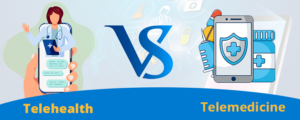How Telehealth Home Care Is Changing The Healthcare Sector?
Telehealth has significantly impacted the healthcare sector. It offers remote medical services, especially during COVID. However, one area that is now gaining massive popularity in telehealth is home care. Which allows patients to get medical care at home from healthcare professionals.
According to the stats, around 42% of patients were satisfied with telehealth home care services. And more people are likely to adopt telehealth solutions over traditional care.
However, many people do not know much about home care telehealth. And how it is shaping medical care services. This blog will explore home care telehealth, its types, benefits, challenges, and future scope.
Table of Contents
- How are Telehealth Revolutionizing Home Health Care?
- Types of Home Care Telehealth Solutions
- Challenges of Telehealth in Home Health Care
- The Future of Telehealth in Home Health Care
- How VCDoctor Can Help in Improving Patient Outcomes with Telehealth in Home Health Care?
- Conclusion
- FAQs
How are Telehealth Revolutionizing Home Health Care?
Here is how telehealth is making a huge difference in home care:
1. Improved Accessibility to Care
One of the most significant benefits for patients is the easy accessibility of care. Telehealth can now provide medical services remotely and at patients’ homes. It allows them to get care without going anywhere. Telehealth platforms removes barriers like distance and transportation. And connects patients and doctors more efficiently for better care.
2. Streamlined Communication between Patients and Providers
Another major reason for telehealth immediate popularity is the virtual consultation between patients and doctors. It means patients do not need to travel a lot and wait in the long queue. Instead, they can schedule a video call at a suitable time at home. And get a personalized consultation with a doctor, saving time, money, and effort. So that is a major advantage of an easy communication option for patients for better care.
3. Reduce Healthcare Costs
When we compare in-person visits with virtual consultations, we find that telehealth virtual primary care consultations save a lot for both patients and doctors by cutting down on travel expenses and other operational costs. Because virtual consultation requires fewer resources than traditional appointments, it means convenience and is more cost-friendly for both patients and professionals to prefer this way.
4. Increase Convenience and Flexibility
Telehealth is revoking home care and making it more conscious and flexible for patients to get care more efficiently by eliminating the need to travel, wait in long lines, or spend money. With the help of advanced technology, patients are now getting care, treatment plans, and consultations at their homes for convenience.
5. Efficient Management of Chronic Conditions
If patients have chronic illnesses, it becomes more challenging for them to visit frequently. This is where telehealth is becoming a more efficient management solution for chronic conditions. Professionals can track vital signs and symptoms remotely and provide personalized treatment plans, helping reduce complications, emergency visits, and hospital stays.
Types of Home Care Telehealth Solutions
Here are some essential types of telehealth solutions that are transforming home healthcare:
1. Remote Patient Monitoring
Remote patient monitoring is the advanced functionalities that telehealth offers. It uses devices like blood pressure monitors and wearable sensors. It is used to track patients’ health status and directly send the data to healthcare providers. Doctors can then monitor all these insights and provide personalized treatment for managing chronic illnesses. This is where technology and doctors combine to deliver better patient care.
2. Virtual Consultation
Virtual consultations allow patients and doctors to communicate over video calls or messages. They eliminate the need to travel and wait in long queues. And making it convenient for patients and doctors to connect at a suitable time. Plus, doctors can frequently discuss patients’ symptoms, treatments, and follow-up care virtually. Virtual consultations are the best functionalities for those areas that medical facilities cannot reach yet.
3. Telerehabilitation
Telerehabilitation means delivering physical therapy virtually. It helps patients recovering from surgery or injuries who are required to exercise daily under expert guidance. With the help of telehealth, patients and therapists can connect over video calls. And provide real time exercise guidance. And ensure patients are doing exercises correctly. So that they can recover faster.
4. Telepsychiatry
In today’s busy world, mental illness has become another major health issue. This is where the demand for Telepsychiatry increases, where patients can virtually talk to counselors or psychiatrists about their mental illnesses and get the best consultation at their convenience to overcome the mental issue.
5. Teledermatology
Patients with skin issues like acne or eczema mainly want professionals to check and give treatment advice regularly. This can be done virtually as well. And that is why people now prefer virtual consultations for Teledermatology. It allows patients to share photos or videos of their skin condition with a dermatologist. And get treatment advice and manage conditions without visiting a clinic.
6. Telepharmacy
Telepharmacy connects patients and pharmacists online to get medication advice or refills faster. Patients can also take guidance on how to take their medicine safely and no. of dose. This service is helpful for patients with complex prescriptions.
7. Teleradiology
Teleradiology allows radiologists to analyze X-rays, MRIs, or CT scans remotely. Hospitals share medical images electronically with radiologists for quick analysis. And to ensure fast diagnosis, especially during emergencies.
Challenges of Telehealth in Home Health Care
Here are some common challenges of telehealth in home care:
- Technical Issues: One of the significant challenges is technical issues. Such as devices not being supported, apps frequently crashing, and the internet not working. These technical issues can arise unpredictably. Which makes it difficult for patients to take virtual consultations or for doctors to provide care.
- Lack of Personal Connection: Telehealth care is a great, convenient option for patients and doctors for quick diagnosis and treatment advice. However, sometimes, it requires an in-person connection so that professionals can diagnose patients more accurately and patients can describe the issues more efficiently. However, it lacks virtual consultation, making the interaction less personal than in-person.
- Internet Access: Stable internet connections are still significant in some rural or low-income areas. Without a good internet, patients can find it challenging to access telehealth services remotely.
- Privacy Concerns: Many people do not prefer telehealth. Because of privacy concerns. Patients need to share their medical histories virtually. So they feel there are chances of data breaches or access without permission.
- Lack of Awareness and Knowledge: Another challenge is the lack of awareness and knowledge among patients. If people do not know what services are available for care at home. How will they access them? Also, some healthcare professionals might not be fully trained to deliver medical services digitally.
- Rules and Insurance Confusion: Telehealth rules vary from place to place. Not all insurance companies cover telehealth services in the same way.
The Future of Telehealth in Home Health Care
The future of telehealth in home healthcare is bright. Technologies like AI, wearable devices, and health tracking options will advance. It allows doctors to monitor patients more closely and intervene earlier. Which leads to personalized care. Telehealth services will also expand to more specialists and areas where earlier access was impossible. Healthcare telehealth will be more accessible, efficient, and affordable with personalized care.
How VCDoctor Can Help in Improving Patient Outcomes with Telehealth in Home Health Care?
VCDoctor is a HIPAA compliant telemedicine solution. It enables doctors and healthcare organizations to utilize the telehealth platform. And deliver their services remotely to patients. And adapt to the growth of home care telehealth. Visit us and explore how our telehealth solution can improve your medical care services.
Conclusion
Home care telehealth is changing the way organizations deliver medical care. Now, it has become more convenient for patients to get medical care at home. With the help of telehealth. Adopting telehealth has numerous benefits and challenges. But the future of telehealth is promising. We hope this guide helps you understand telehealth home care. And how it is changing the healthcare sector. It is time for healthcare organizations to adapt to telehealth.
FAQs
Q. What is home care telehealth?
Home care telehealth allows patients to receive medical care remotely. Through video calls, phone consultations, and health monitoring devices. It also lets people get treatment and advice without leaving home.
Q. Is telehealth effective for chronic conditions?
Yes, telehealth helps manage chronic conditions. By allowing doctors to monitor health and adjust treatments remotely.
Q. What types of services can I access through home care telehealth?
Patients can access various services. Such as virtual doctor consultations, remote patient monitoring, medication management, and more, from the comfort of their homes.
Q. Is telehealth safe for my privacy?
Yes, telehealth follows all the privacy regulations. In order to protect patients personal and health information.




